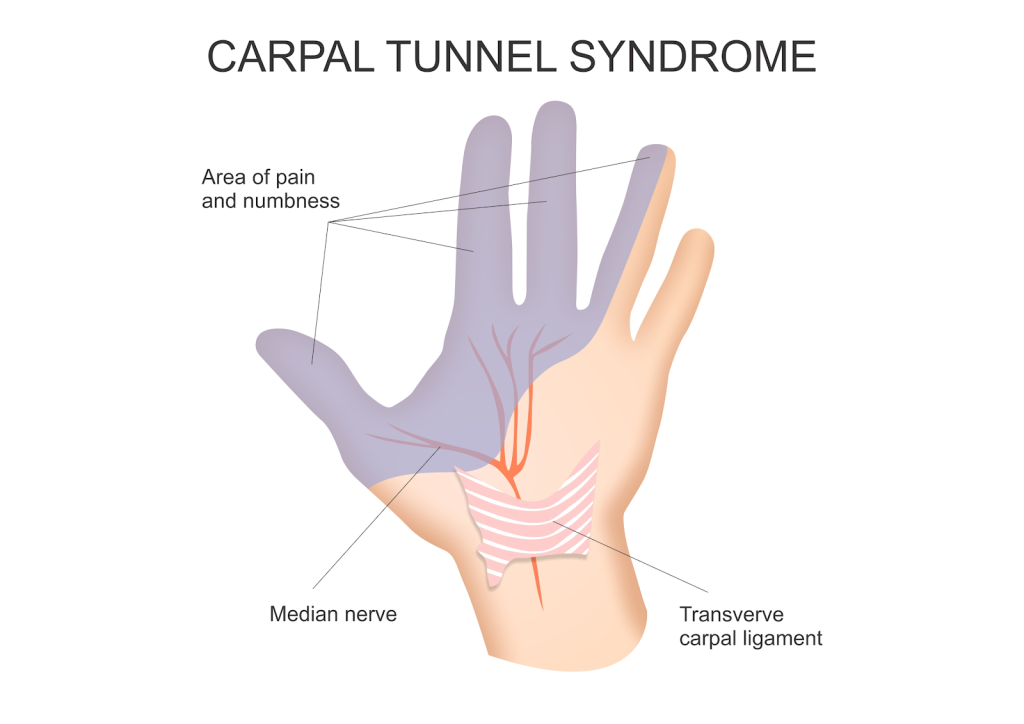
Are you experiencing numbness or tingling in your fingers, or weakness in your hand and wondering if it’s carpal tunnel syndrome? Carpal tunnel is a common condition that can cause discomfort and impact your daily activities. Knowing how to tell if you have carpal tunnel is the first step towards managing this condition. In this article, we’ll guide you through the symptoms, risk factors, and diagnostic methods to help you understand what you’re facing and when to seek professional help.
Key Takeaways
- Carpal tunnel syndrome is characterized by numbness, tingling, and weakness in the hand due to the median nerve being compressed within the carpal tunnel of the wrist.
- Risk factors for developing carpal tunnel syndrome include genetic predisposition, obesity, and certain health conditions.
- Treatment options range from conservative management with medication, lifestyle changes, bracing and rehabilitation exercises, to surgical intervention in severe cases through carpal tunnel release surgery.
At Academy Orthopedics, our expert orthopedic hand surgeons address conditions like carpal tunnel syndrome, trigger finger, thumb arthritis, and wrist fractures. Early diagnosis and treatment can prevent further complications and improve your quality of life. Contact us today to schedule a consultation with our specialist.
👉Also Read: Empathy in Action: Tailored Carpal Tunnel Treatment for Lasting Comfort
Understanding Carpal Tunnel Syndrome

Imagine the median nerve as a vital highway, traversing from the forearm through a narrow wrist passage known as the carpal tunnel, and into the hand. This conduit of sensation and motor function can become a victim of compression—carpal tunnel syndrome—an affliction causing numbness, tingling, and weakness in the hand.
The villain in this tale is often swelling or irritation within the confining walls of the carpal tunnel, a space that can’t easily stretch to accommodate such pressure. When the delicate balance within this passage is upset, the result is a cascade of uncomfortable sensations and compromised hand capabilities, rightfully earning the name called carpal tunnel syndrome.
Identifying Symptoms of Carpal Tunnel Syndrome

The symptoms of carpal tunnel syndrome creep in subtly, beginning with a tingling or numbness in the thumb and fingers, sparing the little finger.
But the impact doesn’t stop at mere sensations; it can delves deeper, causing weakness and muscle atrophy if left untreated.
Nighttime Symptoms
When night falls, the symptoms of carpal tunnel syndrome can become nocturnal nuisances. Individuals may find themselves roused from slumber by a need to ‘shake out’ their hands, seeking relief from the numbness that invades their rest. Pain and tingling become unwanted bedfellows, leading to a night of restless sleep and frequent awakenings.
Hand Weakness and Grip Challenges
Hand weakness associated with carpal tunnel syndrome manifests in an inability to maintain a firm grip, often resulting in a frustrating propensity to drop objects. This decline in motor skills can escalate, diminishing the strength needed for tasks that rely on the thumb, from unscrewing a jar lid to maneuvering a screwdriver.
Precision is also compromised, as buttoning a shirt or handling a key becomes a test of patience and dexterity.
Risk Factors Contributing to Carpal Tunnel Syndrome
Certain individuals find themselves more likely to dance with carpal tunnel syndrome, not by choice but by design. Those with genetically smaller carpal tunnels, especially women, are more susceptible to this condition. Occupations wielding vibratory tools can also lead to carpal tunnel syndrome.
Health conditions such as:
- Diabetes
- Rheumatoid arthritis
- Hypothyroidism
- Obesity
- Pregnancy
Act as fuel to the carpal tunnel fire. Physical injuries to the wrist or conditions like obesity weave into the tapestry of risk factors, potentially leading to the development of carpal tunnel syndrome.
Diagnostic Methods for Carpal Tunnel Syndrome
To diagnose carpal tunnel syndrome, it is akin to solving a puzzle. During a clinical examination, physicians seek evidence of the symptoms’ nocturnal proclivity and how they manifest in daily life. The exploration continues with a physical exam, assessing arm, hand, and wrist strength, sensation, and checking for signs of nerve irritation or compression.
Electrophysiological testing, such as a nerve conduction study and electromyograms (EMG), measures the electrical activity in muscles and the speed of impulses through nerves, pinpointing potential nerve damage and compression sites. Imaging techniques like MRI scans and ultrasounds provide a detailed visual of the hand and wrist structures, offering clarity on the condition of the median nerve and in some instances is recommended by your provider.
Conservative Management Strategies for Carpal Tunnel Syndrome
When carpal tunnel syndrome makes its presence known, conservative management strategies can serve as the first line of defense. These approaches are often effective in relieving the tingling and numbness and restoring hand function without needing to resort to surgical measures.
Medications to Relieve Pain
In the quest to quell wrist pain, medications emerge as allies. NSAIDs, such as ibuprofen, offer a short-term respite from discomfort, although they may not lead to long-term improvements. Corticosteroid injections, on the other hand, can be precisely delivered into the carpal tunnel to provide more focused and effective short term relief.
These medical interventions, including carpal tunnel surgery, are commonly recommended to prevent carpal tunnel syndrome and reduce pain and inflammation associated with it.
Lifestyle Adjustments to Reduce Symptoms
Beyond medications, lifestyle adjustments can play a pivotal role in helping you manage carpal tunnel syndrome. Here are some tips to help alleviate symptoms and prevent their progression, so you don’t develop carpal tunnel syndrome:
- Maintain proper posture and ergonomic workstation setup
- Modify activities that stress the hand
- Adopt ergonomic practices
- Avoid vibratory tools
Following these tips can provide significant relief.
Using ice to reduce inflammation and wearing a wrist splint to minimize pressure on the median nerve can also be effective strategies.
Rehabilitation Exercises
The road to recovery often includes rehabilitation exercises. Nerve gliding exercises, for instance, can enhance nerve conduction and support the healing process for carpal tunnel syndrome patients. Supervised exercise programs, designed to alleviate pressure on the median nerve, are a strategic addition to the rehabilitation regimen.
Surgical Intervention: Carpal Tunnel Release Surgery
For cases where conservative measures fall short, carpal tunnel release surgery steps into the spotlight. This surgical approach aims to relieve pressure on the median nerve by releasing the ligament pressing on it, providing a more permanent solution for those with severe symptoms.
Understanding Carpal Tunnel Release Surgery
Carpal tunnel release surgery can take different forms, such as open carpal tunnel release and endoscopic carpal tunnel release, with each method designed to enlarge the carpal tunnel space by dissecting the transverse carpal ligament.
While the surgery is often effective, it does carry potential risks such as:
- Pain
- Infections
- Scarring
- Nerve damage, which may lead to complications like weakness, paralysis, or loss of sensation.
Post-Surgery Recovery Tips
After surgery, recovery becomes the focus. Patients are often advised to:
- Wear a splint or wrist brace for several weeks, allowing for light activities while supporting the healing process.
- Keep the hand elevated above the heart to reduce swelling.
- Perform gentle finger movements to prevent stiffness.
It’s also crucial to keep the surgical incision clean and dry to ward off infection and encourage healing.
Promoting Healing After Surgery
The journey to recovery doesn’t end with surgery; it’s also about promoting healing in the aftermath. Physical therapy plays a vital role in preventing scar tissue formation and regaining wrist strength with exercises tailored to the patient’s needs.
A diet rich in anti-inflammatory foods like brightly colored vegetables and omega-3-rich fish supports the healing process, while avoiding pro-inflammatory foods can further aid in symptom management and recovery.
👉Also Read: Discover Relief and Support: Experience Personalized Care for Carpal Tunnel Syndrome
Take Action Now for Relief from Carpal Tunnel Syndrome
We’ve traversed the intricate landscape of carpal tunnel syndrome, from its subtle onset to the decisive actions required for relief. It’s a condition that can quietly infiltrate daily life, but with the right knowledge and approach, it’s one that can be managed and overcome. Whether through strategic lifestyle changes, targeted exercises, medications, or even surgery, there are paths to reclaim the comfort and function of your hands.
Don’t let carpal tunnel syndrome interfere with your life any longer. If you’re experiencing symptoms or want to learn more about managing this condition, reach out to Academy Orthopedics today. Our experienced team, led by Board Certified hand specialist Dr. Jonathan Katz, is dedicated to providing you with personalized care and effective solutions. Contact us now to schedule a consultation and take the first step towards relief and restored hand function. Your hands deserve the best care—let us help you get back to living your best life.
Frequently Asked Questions
What are the first signs of carpal tunnel syndrome?
The first signs of carpal tunnel syndrome usually involve numbness and tingling in the thumb, index, and middle fingers, especially at night, and can advance to hand weakness and difficulty with gripping objects. These symptoms should be addressed promptly to prevent further complications.
Can carpal tunnel syndrome be managed without surgery?
Yes, carpal tunnel syndrome can be managed and symptoms relieved with conservative treatments such as splinting, medications, lifestyle adjustments, and rehabilitation exercises. Surgery may not be necessary for all cases.
How long is the recovery after carpal tunnel surgery?
Recovery from carpal tunnel surgery can take several months, with most patients able to return to light activities within a few weeks.
Are there any dietary considerations to help with carpal tunnel syndrome?
Incorporating anti-inflammatory foods like brightly colored vegetables and omega-3-rich fish, while avoiding pro-inflammatory foods, can help support the healing process and reduce symptoms of carpal tunnel syndrome.
What are the risks of carpal tunnel release surgery?
The risks of carpal tunnel release surgery may include pain, infections, scarring, nerve damage, weakness, paralysis, loss of sensation, or stiffness, underscoring the importance of consulting a healthcare provider before making a decision.
Can I stay awake for carpal tunnel surgery?
Yes, the specialists at Academy Orthopedics frequently perform carpal tunnel release surgery utilizing a technique known as WALANT. This stands for Wide Awake Local Anesthesia No Tourniquet. This technique uses an injected numbing agent to anesthetize the area and allow for a pain free surgery while staying awake. Learn more today! WALANT Surgery
